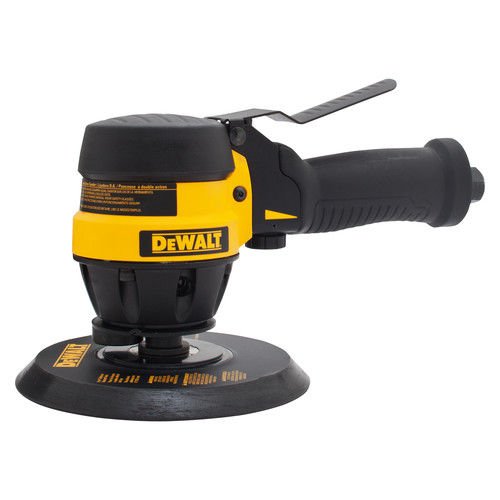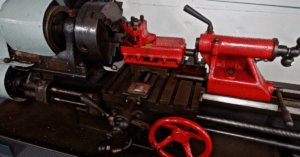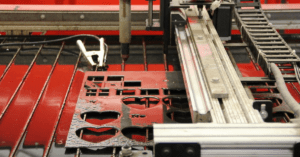
Are you tired of sanding wood manually? You are not alone. As a woodworker, I am always on the lookout for tools to help me finish a project efficiently. One of the devices that caught my attention is the DA sander.
A DA (dual-action) sander is a powerful tool that works like a belt and disk sander in one. It moves back and forth like a belt sander. However, it also rotates, similar to how a disk sander works.
DA sanders are also versatile, making them ideal for various tasks. The rest of this article will cover the dual-action sander in detail. I will teach you its several applications and share tips on how to use it properly.
What Is a Dual-Action Sander?

A dual-action sander, also known as a DA sander, is a versatile power tool for woodworking. It borrows features from the belt and disk sander to help you perform tasks efficiently. However, it is not a replacement for these two types of power tools.
I will briefly show you how the belt sanders and disk sanders work to help you understand dual-action sanders.
A belt sander uses a belt of sandpaper to smoothen surfaces in a linear motion, hence its name. It also operates at high speeds, making it ideal for removing lots of material quickly.
On the other hand, a disk sander spins a sanding disc to remove rough patches from a surface. It can also move irregularly to polish uneven objects, like a random orbital sander.
The dual-action sander moves back and forth to copy the belt sander’s linear motion. However, it also rotates, either in a random or purely rotary pattern. It ultimately offers two functions, which give you more flexibility over the final project results.
How Does a Dual-Action Sander Work?
Dual-action sanders work differently, depending on the exact model.
Some devices feature a circular sandpaper that spins like a disk sander. Meanwhile, other models use a rectangular sanding pad that moves in a slightly rotary pattern without turning the paper.
That said, most DA sanders work in two different modes.
The first mode allows you to lock the sandpaper in a spinning motion. It can sand flat surfaces quickly.
Once you switch to the second function, the internal bearing moves the pad around. This movement has a noticeable wobble to polish surfaces without creating too much friction. The end result is a smooth material finish without scratch marks.
Simply click the button on the DA sander to switch from sanding (spinning) to buffing (wobbly) mode.
What Do You Use a DA Sander For?
A DA sander offers many applications, thanks to its two-in-one function. Some common uses include the following:
- Sanding large wood surfaces to achieve a smooth finish without deep scratches or marks
- Polishing metal materials, such as car body panels and metal furniture
- Removing paint and varnish from different materials, like wood and metal
- Smoothing and shaping plastic
- Sanding drywall to prepare it for paint or wallpaper installation
- Creating intricate patterns on wood
- Handling multiple wood pieces with different grain patterns
How Do You Use a DA Sander?
It can be overwhelming to operate a DA sander for the first time. Below, I will share a step-by-step guide on how to use a dual-action sander efficiently.
- Wear the appropriate equipment to ensure your safety. These include eye goggles, work gloves, a dusk mask, and a pair of steel-toe boots.
- Choose the sandpaper grit that best suits your project. A lower grit (such as 60) leaves a coarse surface, ideal for heavy material removal. Higher grits (such as 220 or 320) offer a fine and smooth finish.
- Attach the sandpaper to the DA sanding pad. Refer to the product manual for specific instructions.
- Switch on the dual-action sander.
- Start sanding the surface using a back-and-forth motion. Follow the wood grain to prevent noticeable sanding marks.
- Use the lowest speed setting to remove heavy material. Switch to a higher speed for a smooth finish.
- Continue using the DA sander to polish any rough spots. Avoid staying in one area to prevent oversanding.
- Turn off the DA sander.
- Clean the surface and vacuum the dust after using the DA power tool.
Note that these are general steps for using a dual-action sander. It is best to follow your manufacturer’s instructions for specific usage recommendations.
What Is the Difference Between a DA Sander and an Orbital Sander?
A dual-action sander is often confused with an orbital sander. However, it is distinct in several ways.
Below, I will teach you the differences between a DA sander and an orbital sander.
Movement
The sanding pad movement is the main factor that sets a dual-action sander apart from an orbital sander.
Orbital sanders are limited to an orbiting pattern, hence the name. However, DA sanders can move in both circular and linear motions.
Speed or Efficiency
DA sanders and orbital sanders also differ when it comes to their speed and efficiency.
The dual-action sander revolves around its spindle. Think of it as the earth’s rotation. It also delivers a wobbly motion that minimizes friction and heat buildup.
Due to this shaky movement, the DA sander can only offer speeds ranging from 1500 to 7000 rotations per minute (RPM).
In contrast, an orbital sander takes advantage of the motor to create circular motion. The increased momentum leads to increased speed. This power tool can reach the 7000 RPM mark with ease.
Ergonomics
Dual-action sanders feature a compact profile. They usually have small grips and handles. These offer better control, especially if you are working for long periods.
Orbital sanders have slightly larger handles. Depending on the size of your hand, these are still relatively easy to grip.
I recommend testing both tools in-store to find a product that feels the most comfortable in your hands.
Uses
I have already covered the applications of a DA sander above. But to reiterate, this power tool can sand various surfaces, remove paint, and smoothen edges. A dual-action sander can also erase scuff marks and leave a fine finish.
An orbital sander is also a great tool for carpentry, woodworking, and auto works. However, it mostly focuses on smoothing uneven surfaces. It can also remove the top layer of materials, so you can apply paint directly.
Price
The cost of a dual-action sander varies greatly, depending on the model, size, and features. For instance, a DA sander with a built-in battery is more expensive than plug-in models. Devices with filter bags and vacuum hoses also cost more than those without these extras.
The same could be said for orbital sanders. Small, compact models are affordable. However, larger devices with additional features are more expensive.
DA Sander vs. Orbital Sander: Which Is Better?
Both dual-action and orbital sanders are powerful tools for woodworking projects. Choosing between the two depends on your needs and personal preferences.
Dual-action sanding tools use both linear and circular motions to accomplish various tasks. These include sanding, polishing, and smoothing different surfaces. They are suitable for DIY woodworkers and professionals alike. The only downside is that they leave swirl marks.
On the other hand, orbital sanders move in irregular circular patterns. They can prevent swirls from appearing on the surface. They can also remove rust and paint to prepare the surface for fine detailing.
Conclusion
You can complete your woodworking projects in no time with a DA (dual-action) sander. This powerful tool combines the features of belt and disk sanders into one. It can help you sand, smoothen, and polish different surfaces, including wood and metal.
Do you want to learn more about a DA sander? Feel free to drop a message on our contact page.






